Bigger is Not Always Better
Can a videogame be the solution to childhood obesity? One research community believes it’s worth investigating
By Michelle Carlson, Contributor 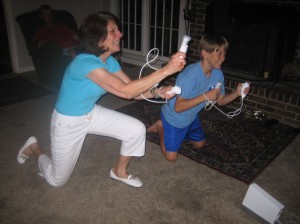
The Tanita Healthy Weight Community Trust has awarded the Senior Lecturer in Exercise Physiology at Derby University £5,000 to complete a research study on the effects of Wii and childhood obesity.
“There is a lot of discussion that video games are bad for your health and we hope this research will determine if playing on this equipment could actually have physical benefits for children,” said Michael Duncan the Senior Lecturer in Exercise Physiology at Derby University, in an interview with PhysOrg News.
Childhood Obesity and Video Games
The good old outdoors was a commodity many people took advantage of when they were children.
“Some of my best memories were from playing games outside,” said junior Siobhan Kane, who still plays intramural basketball and is a certified EMT. “I mean I wouldn’t have half these scars if it wasn’t for tag, hide and seek, or capture the flag.”
Now with all the technology available, many children have become accustomed to a sedentary lifestyle; opting to play video or computer games rather than playing outside.
According to the new physical activity recommendation presented by the government in Oct. of 2008, children should participate in one hour or more of moderate or vigorous aerobic physical activity a day, at least three days a week.
“Though Wii does get the blood flowing, I do not think that it counts as a ‘moderate or vigorous’ activity,” said senior Anne Marie Person who is majoring in Health Promotion. “I think maybe the affect that it does have is getting kids off their butts and on their feet. Then once they are up maybe they will want to go outside and play a real game of baseball or tennis.”
Wii is new type of video game created by Nintendo that allows children to physically control the game through their movements. There is a console that retrieves the players’ motions which in turn simulates the player’s command. For example, a gamer can use the remote to play tennis, boxing, bowling, or golf.
“I just played the Wii all Thanksgiving Break with my nieces and nephews and I was surprised when I began to sweat,” said Person. “I think it is a fun proactive game for people of all ages to play.”
What is Tanita?
Tanita, also known as the Tanita Healthy Weight Community Trust, is the company currently funding Dr. Duncan. Tanita’s goal is to prevent obesity through scientific study and was created because of the continual rise in obese people globally. The organization gives out 6 to 8 grants a year, and the term of each grant is 10 months, beginning the day the subsidy is awarded.
According to their website, the Tanita Healthy Weight Community Trust is a non-profit, public fund whose goal is to educate and “combat obesity worldwide.” They were established in 1994 by Tanita in cooperation with the government of Japan.
The Study
Dr. Duncan said the study will take place over a six week period at a local area elementary school. He plans on dividing the children into two groups. The one group will play Wii for 30-minutes during their lunch period, while the other group will participate in regular sports. All the participants will be connected to heart-monitor which tracks the heart rate and amount of calories burned. Duncan hopes to provide Tanita with his results in the next year.
Childhood Obesity
While some analysts say that inactivity and the progression of technological gadgets are the reasons for the increase in childhood obesity, Dr. Robert Karch says that childhood obesity has been around for thirty some years.
“Childhood obesity is not new; it’s just getting a lot of recent attention,” said the chair of American University’s Department of Health and Fitness Dr. Karch. “It is an emerging derivative from the 1960s when schools began cutting curriculum in order to incorporate more mathematic and science courses.” Karch believes other contributing factors are from the increasing urbanization and fast food restaurants. He believes more attention is being focused on the issue of childhood obesity because of the available tools now able to diagnose diseases faster.
“We weren’t looking for it before in kids, we only focused on adults,” said Karch. “The world has also come to realize the phenomenal cost, both financial cost and human cost, that obesity causes. It’s an issue because it’s a controllable variable.”
The Pros and Cons of Virtual Activity
Dr. Karch is a supporter of the technological advancements taking over our world as long it is used properly. Karch says that this generation of children has shifted towards more technology based entertainment versus the traditional physically active games.
“We can’t be in denial of this generation of kid’s interest in technology,” said Karch. “It’s not as fashionable to play outside, so finding ways to get people physically active through technology is a very positive progression.”
Karch says a big positive of virtual gamming is that the player is able to be active in a controlled environment without the fear of public failure.
Strive Fitness Equipment has even begun targeting the younger generation with “Kidz Smart Circuits.” They call it Smart Strength Technology and say it provides a total-body workout in 30-minutes or less.
The downfall is much of these games and equipment are expensive commodities. The Kidz Smart Circuits are sold individually and run for a couple hundred dollars. A Wii will cost the buyer $329.95 for just one controller and console, and for those who wish to interact with multiple players other remotes can be purchased for $40 each. You can then add to your shopping cart the Wii Fit for an extra $189.99 or the DreamGear Wii 5-in-1 Fitness Bundle for $60.
Karch says the expensive prices may deter people from buying the virtual games. The Wii also only allows for the maximum of four people to play at a time, which makes the virtual game socially restrictive and less interactive.
Weight-Loss
Chief Operating Officer of L&T Health and Fitness, Allison Flatly attributes childhood obesity to kids spending less time exercising, and more time in front of the TV, computer, or video-game console. She is currently working with children to get them more active. Flatly says the research being done on the topic can only bring about improvement for our ‘larger’ growing community, but doesn’t think the videogames will be solution to the problem.
“According to a study done by the American Council on Exercise, ‘Wii workouts’ definitely burn calories; which is a lot better than sitting on the couch watching TV or playing a non-active video game,” said Flatly. “But as for Wii changing the obesity rate, I don’t think it compares to traditional physical activity.”
The irony of “Jewish” tattoos on Jews
By Erica Goldfine, Contributor
It is a Jewish commandment, from the third book of the Torah, that Jews shall not get tattoos. Yet many Jews get tattoos anyway, many of them with Jewish themes or Hebrew lettering.
What the Torah says
“You shall not etch a tattoo on yourself,” Leviticus 19:28. Jews believe that because the body is G-d’s creation, putting a tattoo on your body violates G-d’s creation and “mutilates” the body.
The three main sects of Judaism: Orthodox, Conservative, and Reform, all agree that Jews’ bodies belong to G-d and they should not be tattooed.
“…Our bodies are to be viewed as a precious gift on loan from G-d, entrusted into our care but not our personal property, to do with as we choose,” the United Synagogue of Conservative Judaism (USCJ) said, on their website, regarding getting a tattoo.
The big myth
Many Jews today believe that getting a tattoo forbids them from being buried in a Jewish cemetery. Many Jews are also concerned that Holocaust survivors, who were tattooed by the Nazis to identify the Jews, would also be forbidden from being buried in a Jewish cemetery.
But according to Rabbi Scott Mathais this belief is a myth.
“Anyone that has a tattoo can definitely be buried in a Jewish cemetery…there is basically no case in your average Jewish cemetery around the world that you wouldn’t be able to get buried there,” Mathais said.
He also said that although there are some Jewish organizations that run cemeteries that do forbid tattoos, they are few and far between. Mathais said that these groups are the reason why many Jews believe that getting a tattoo forbids them from being buried in a Jewish cemetery.
Mathais also explained that only the act of getting a tattoo is forbidden by the Torah, but having a tattoo is not. Therefore, once a person has a tattoo, it does not need to be removed.
Getting a tattoo
Billy Bennett, a tattoo artist at Tattoo Paradise in Washington, DC, and Silver Spring, Maryland, said that when a tattoo is done properly, the needle will go through a few layers of a person’s skin. He said the depth of the incision is “about the width of a dime” so that it will not hit a vein.
“It (a needle) doesn’t go too deep but it definitely goes deep enough to stay forever, if it done right,” Bennett said.
According to the USJC one commentator of the Mishnah, or Jewish laws, said that it is the permanency of tattoos that makes them forbidden. It is debated by other commentators on the law whether or not this is the reason.
Chabad.org, a Jewish Orthodox organization’s website, said that one reason may be because idol worshippers got tattoos to worship their multiple G-ds. Because the Torah says multiple times that Jews must not “emulate pagan customs,” tattoos are forbidden, the website said.
Tattooed Jews with Jewish themes
Not only is there a controversy about getting tattoos, but it turns out many Jews are actually getting tattoos in Hebrew. Bennett said that people come in approximately a couple of times a month wanting tattoos in Hebrew, the language of the Torah and the language of the Jews. He also said that religious tattoos are one of the most common tattoos in the shop where he works, particularly in males ages 20 to 25. (Click here to hear Bennett’s view on religious tattoos)
American University student, Garrett Asta, who goes to religious services on major Jewish holidays, has a tattoo across his upper back. Asta’s tattoo, which he designed himself, is a design with his last name in the shape of a Jewish star and in the colors of the Italian flag.
“I wanted to get a tattoo for a while before I started designing it, that it had some relevance to my heritage and basically a display of pride in it,” Asta said.
Asta also said that although he knew of the Jewish commandment to not get tattoos, he got one anyway. He said that because he is still permitted to be buried in a Jewish cemetery, he is okay with contradicting the Torah.
Todd Weinberger, the Creative Director of Inked Magazine, recently got his first tattoo. The tattoo is a Hebrew phrase, l’olam vaed, which means “forever and ever and eternity.” Weinberger got his tattoo on his left arm as a symbol of commitment to his girlfriend, Jenn Goldstein, who got the same tattoo in a different Hebrew font on her neck.
Weinberger said that he is proud to be Jewish but is not extremely observant. He grew up in a religious Jewish home but as he got older he said he became more spiritual about his observance. Like Asta, Weinberger got his tattoo even though he knew of the law in the Torah.
“I feel that Judaism needs to adapt to the times, and having a Hebrew tattoo is a sign that I am Jewish and damn proud of it,” he said in an email.
Flying High
Unscripted: the life of an Eagle
By Jimmy Hascup, Contributor
Garrison Carr is to American University what Barack Obama is to the United States. A celebrity is an understatement.
While Barrack Obama will be the first black president, Garrison Carr is the leader of an AU basketball team who made a different kind of history and took part in a different kind of season.
And right now Garrison is gearing up to continue his spectacular career at American, with the season home opener this week.
For the first time in the school’s 41 years of Division I play, AU took part in March Madness and made it to the NCAA Tournament last year. They finished with a 21-12 overall record. It was due in large part to the senior’s (then a junior) stellar season where he averaged 18.4 points per game and shot 45.2% from the 3-point arc.
Popularity
Carr is more than just a shooting machine.
The 5’11”, 170 lbs. shooting guard was born in Belleview, WA and is majoring in marketing. The AU Eagle is popular on campus “because he’s a nice young man and people connect with him,” says AU basketball assistant coach Kieran Donohue.
Garrison is more than just a star on the basketball court. Donohue attributes this to “a genuineness of character that people realize and appreciate.” Just look at his Facebook profile where he has 1,315 friends (and counting).
Carr said that his parents instilled in him his hard work ethic and taught him to be a likeable person.
Donohue’s wife attends nearly every game. No matter the outcome, Carr always has the time to speak to her and ask her how she’s doing. Donohue calls it Carr’s “genuineness of personality” that’s brought out when he speaks to other people. He said Carr never seeks attention and doesn’t have an “exuberant personality.”
Brian Gilmore, a teammate of Carr’s, lived with Carr on road trips for his freshman and sophomore years. “You never get that guy in the locker room in a bad mood. He always comes in with a smile and ready to joke around. Whether it’s dancing or doing the two step or telling a joke or laughing at someone else’s joke, he’s just always energetic and upbeat.” He called him a “fun guy to be around.”
Lessons From Home
Carr says he is respectful because he wants to leave a good impression. “My parents always used to refer to how I’m remembered,” says Carr. “And they’d always say when you’re talking to someone show respect and when I do things, do them to the best of my ability so people remember me in a positive light instead of a negative light.” Garrison also says he wants to be a role model for his little sister. Since she looks up to him he wants to lead by example. He wants to show her the value of doing everything to the best of your abilities and the importance of being well-mannered in public.
Garrison’s father was the key figure in his life. He says his father always held him to high standards—motivating him to come in first in team sprints and pushing him to be better and more successful than he was.
Brian Gilmore says that Carr expects a lot from people. While he’s funny and loose off the court, he’s focused and intense on it and expects the same effort out of teammates. “He is more of a quiet leader, who just works hard at everything he does—more by example rather than being vocal,” says Gilmore. “The guy does everything he can 110% and a lot of the younger guys follow that work ethic.”
Carr expects a lot out of himself, too. “I’m the most critical on myself, more than anyone,”
he says. He’s always thinking about what he can do better and never accepts losing.
Schoolwork piles up for Carr—a result of his rigorous basketball schedule. This semester he remembers working on a paper. He struggled to get through it, but he stayed up all night, until it was perfect. He wanted to give up on it, but just thought that he had to “keep working and give it [his] best.”
Future
Carr’s goal is to play basketball when he graduates, but will definitely use his education as a fallback option. Other than going to the tournament, he says signing his scholarship papers was his biggest accomplishment. Carr has always been an obvious athlete, yet his future on the basketball court was doubted because he is considered short for a basketball player. He says he never let that bother him though and used his strong work ethic to overcome it.
Donohue says, “Garrison understands what it takes to be successful and he is willing to do what it takes to be successful.”
Ultimately Carr aspires to be like his father. He lives by his father’s teachings that he “should surpass everything he did to make things better for his [own] family.”
Working and Studying
While good grades remain a focus, many students see being employed as equally important
By Kelsea Edgerly, Contributor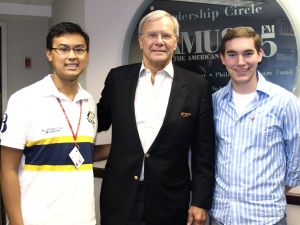
Each academic year undergraduates are choosing which classes they take each semester and many are also applying for jobs.
More and more students are attempting to balance a normal 15 credit (or more) academic schedule with a weekly work schedule. And these students are looking for employment for a variety of reasons, ranging from pressure at home to help pay for school, to simply wanting more pocket money.
Leigh Ellis, a sophomore Women and Gender Studies major at American University, says she decided to apply for a job this school year because “it allows you to become more financially independent, and learn how to budget your money. But college isn’t cheap, so a lot of my money will go to paying off my loans.”
Students like Leigh are faced with the difficult task of juggling academics and employment. But employment can mean an off-campus job not at all related to the student’s school, or a federal work study job, either on or off campus.
Helped or hurt by federal work study?
While working even five hours a week can significantly reduce a busy student’s free time, many students working on campus are obliged to do so by work-study requirements included in their financial aid packages.
Tasha Daniels, the Student Employment Coordinator for the Federal Work-Study program in the Career Center, says the first thing she does with students when they come into her office is help them figure out if they want to go off-campus or stay on.
“Off-campus requires a little more time when you factor in all the travel, so you have to know that you either really want to do this and you have time for it. If not, then I steer them towards on campus jobs,” said Daniels.
Most on-campus federal work-study jobs at American University are happy with students working five to 10 hours a week. The maximum number of hours students are allowed to work is 20 per week.
Edward Levandoski, a sophomore in the School of Public Affairs, holds a Federal Work-Study job in the Career Center as a peer advisor. Edwards says his campus job doesn’t stress him out but all the other groups and clubs he is involved in does stress him out.
“Since there are 6 peer advisors, in the event of a conflict it is rather easy to switch shifts with someone, which greatly reduces any stress,” he said.
Tasha Daniels said that this year around 3,000 students were awarded Federal Work-Study packages as part of their financial aid. But only about 1,000 of them accepted.
As for off-campus employers, Daniels said, “I stress to them that they are taking students, and they’re students first, so that has to be taken into consideration, in asking them to be considerate of things like exam week. Students need to study.”
Occasionally, some students also work summer jobs for their federal work-study employers. DonMike Mendoza, a junior Broadcast Journalism and Musical Theater double major, worked at WAMU Radio through the federal work-study program his entire sophomore year. He then was offered a job for the following summer.
“They’ll keep you if they really like you. The summer job wasn’t a definite unless they were happy with my work. But they asked me to stay. So, in a way, it is a real job,” he said.
Balancing life on and off campus
It’s not just upperclassmen looking for experience outside of the classroom these days. Tasha Daniels sees underclassmen are just as eager as upperclassmen to work government jobs off-campus.
“This semester was predominantly freshmen who went out for those positions. Which I was shocked about because they’re going off campus and they’re new but they’re…adventurous,” said Daniels.
Leigh Ellis comes to campus on Mondays and Thursdays and attends class from 10 am until 8 pm on both days. On Tuesdays and Fridays she works 9 am to 5 pm at the National Park Service in downtown DC. She rides the metro bus into the city on work days.
Some students experienced working full-time in high school and doing fine on their grades. Many expect to be able to continue working full-time in college and continue to make good grades.
“It’s definitely exhausting. Sometimes at the end of the week I just sit and think ‘Why am I doing this?’ But I actually really love my job, and the experience it’s giving me,” said Leigh.
Edward Levandoski says the key to finding a balance is learning how to budget time. He says if students schedule their time appropriately, they can handle it.
“As students, we will be getting internships, balancing club involvement, and other commitments with school work, so this is a necessary skill to acquire, ” said Levandoski.
Whether they prefer working on campus or off, many more students are deciding a job is worth adding to their load. Some eagerly begin working at the beginning of the year, only to find that the stress is too much, and drop their jobs. However, more often than not, the majority of working students say the benefits of gaining job experience is worth the stress in the long run.
A Hidden Bomb
The Effects of Nuclear Weapons
By Alexis Rodriguez
WASHINGTON – In an instant 150,000 people die, millions more injured, and still today hundreds and thousands more dying – but it’s not an epidemic like Black Plague or Aids that’s killing these people – it’s a nuclear bomb that was dropped on them 64 years ago.
The U.S., responsible for dropping nuclear bombs in Japan, has continued to construct more. The Obama administration will face some critical decisions about the future of the U.S. nuclear weapons programs.
According to Sushi Fujioka, a professor specializing in nuclear warfare from Ritsumeikan University in Japan, the nuclear weapons the U.S. has are capable of creating a nuclear winter.
“A nuclear winter is when the mushroom cloud of a bomb is so strong that it covers the entire earth for months hindering sunlight and killing all life on earth,” said Fujioka.
The U.S. has tested over 2,000 nuclear weapons and has constructed over 60,000 according to Fujioka. “That’s more than enough times to create a nuclear winter 6,000 times around the entire earth,” said Fujioka.
Awaiting 2010
The U.S., along with the Soviet Union, are the world leaders of nuclear development. Steven Leeper, Chairman of the Hiroshima Peace Culture Foundation has been a strong enforcer of nuclear nonproliferation. He believes the nuclear weapons should be banned. During a lecture he gave students in Nagasaki, Japan, he spoke of The Nonproliferation Protocol of Nuclear Weapons Review Conference.
“It is crucial to end nuclear proliferation and disarm nuclear nations,” said Leeper. “For this to occur, we all need to take a voice and stand up for this.” The protocol would be reviewed in New York City in 2010.
Leeper also mentioned that Sen. Barack Obama agreed to nuclear nonproliferation after being subjected to his nuclear lectures. “The U.S. should lead the race in a nuclear free world,” said Leeper. “It is essential to the world because the U.S. is a super power; so, we should lead the way in change, and non-proliferation as an example to the other nations who still poses nuclear weapons.”
If the protocol is approved, nuclear weapons could be completely abolished by 2020. “But this is only possible with civil society pressure and persistence,” said Leeper.
Only South Africa has given up their nuclear weapons. North Korea continues to dismantle their nuclear weapons because of the Nonproliferation Treaty of 1985.
The United Kingdom’s arsenal wants to do the opposite and renew their nuclear weapon making past the year 2050.
Why the US Keeps their Nuclear Weapons
According to USA Today, the Pentagon says the main reason for the development of nuclear weapons is to protect the U.S. from attacks from possible nuclear and chemical attacks from North Korea, Iran, and Libya.
Mohamed ElBaradei, head of the International Atomic Energy Agency, told Germany’s Stern weekly, “The U.S. government demands that other nations not possess nuclear weapons. Meanwhile, it is arming itself.”
The Pentagon fears that those nations have stored much of their weaponry in their underground bunkers.
“Without having the ability to hold those targets at risk, we essentially provide sanctuary,” said J.D. Crouch to USA Today. Crouch is an assistant secretary of Defense to the Bush Administration.
Michael Chang, a pre-law student at George Mason University says, “I think they’re [nuclear weapons] beneficial to the U.S…. They need to deter other countries from having them.”
What the Survivors are Doing
According to Koko Tanimoto Kondo, an 8 month baby during the dropping of the first atomic bomb in Hiroshima, Japan, she hated the Americans for all the suffering they had caused. But as time went by her view changed. “I don’t need to worry,” said Kondo during a lecture in Kyoto, Japan. “I depend on you… you will make a better world.” Kondo at 63 remains a strong activist against nuclear proliferation and is one of the last survivors of the atomic bombings in Japan.
Mary Dickson, a downwinder and famous playwright living in Salt Lake City, Utah, has also played a strong role in her community to help end proliferation.
Subjected to nuclear contaminants in the air, because of testing in the Nevada Test Site, she has helped convince former mayor of Utah and President of High Roads for Human Rights, Rocky Anderson that people are entitled to a nuclear free world. 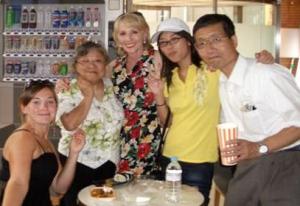
“I’m helping him to focus on the nuclear abolition issue,” said Dickson. “Nuclear weapons serve no strategic purpose.”
According to Dickson, the US has tested 928 atomic bombs since 1951-1992 on US ground mainly in desolate areas in the Southwest. The site
(Left student, Koko Tanimoto Kondo, Mary Dickson, student, Sushi Fujioka, taking a break after speaking of nuclear weapons in Nagasaki, Japan)
remains a wasteland.
People living downwind from the site are developing early stages of cancer and disease. The US government has medically compensated for little to none of the expenses of the downwinders.
“It’s like many of the people were in the war, except they’ll never fold a flag over our coffins,” said Dickson.
Proposition 8: “That’s so gay”
Millions gathers to protest, but now what? Three openly gay men offer some perspective
By Maureen McCarty, Contributor
An estimated 60,000 people braved the rain on Saturday in Washington to march on the White House in protest of the passing of Prop. 8 in California. Across the nation, as well as in Canada, Australia and England, close to a million people gathered together to show their support for the gay and lesbian community, according to estimates by the San Jose Mercury News. But now that the banners are gone and the crowds have dispersed, how effective were they?
One marcher, Jon-Carlo Canezo, 20, held high hopes for the demonstration despite the weather. However, Canezo doesn’t believe the protest has any sort of political resonance, but rather a way for the public to join together and show their support for the gay community.
“Here’s your cookie for marching, but now what?” said Canezo the day after the protest.
While reflecting on the events the day before, Tom Joudrey, who also marched in the rain, said the purpose of the march was to make bring the homosexual community to the forefront. “It’s much easier to scapegoat or demonize a group when you can’t see its human face,” he said.
Joudrey, said that although the legislation doesn’t directly effect his rights, it’s important the entire community to remains active.
“It does set a precedent in legitimizing anti-civil rights laws even in areas that have a high concentration of gays and lesbians,” he said.
Supporters in California met at Bill DeFrank Lesbian and Gay Community Center in San Jose on Monday to plan the next move, according to the San Jose Mercury News. San Francisco gay rights leaders are planning a “town meeting” on Thursday to encourage similar planning meetings across the nation, reported The Mercury News.
Despite the progress, many still question how close we are to establishing equal rights for the gay community. One of Canezo’s favorite signs said, “I can’t believe we have to protest this shit.”
The Language that Binds
While the protests raised awareness and camaraderie within the community, some say there is still a language used by the general public that oppresses. According to Canezo, many in the community are taking control of negatively connoted terms used as synonyms for homosexual as a form of empowerment.
“They’re just words and they can hurt, but they only hurt if you let them,” said Canezo.
For Canezo, using those words is similar to the language used toward African Americans before the Civil Rights movement.
“Actively using words like ‘queer’ in our discourse is part of a process of re-appropriation,” said Joudrey.
Some of the stronger language is used to describe lesbians. Joudrey, who also marched with Canezo on Saturday, uses some of the strongest terms to address his friends.
“Most laugh it off,” he said. “It’s OK to use the term if you’re gay or a lesbian, but if someone outside of the community were to call me something—that’s not alright.”
Twenty-year-old Michael Ginsberg, Canezo’s roommate, disagrees. “I don’t see much difference between [heterosexual and homosexual people] using it– it’s damaging either way,” he said.
Canezo said using “gay” to describe something “lame” is a generational reflex. While it’s hurtful, he admits he sometimes slips as well.
“Just as the older generation still uses the N-word, our generation still uses the G-word,” said Canezzo.
“Preference, not Prejudice”
“As an Asian/Pilipino gay man dating a deaf man, I’m used to prejudice,” said Canezo. When most think of a gay man, they have the image of someone white and middle class and promiscuous, according to Canezo. This includes those within the community.
Two years ago, Canezo said he entered a relationship with an intern, who Canezo would like to keep anonymous, on Capital Hill. After dating for two months, the intern, originally from Florida and devoutly religious, openly admitted to Canezo that he couldn’t commit to a relationship with him because he wasn’t white.
“There’s an idealization to what a homosexual man should be,” said Canezo. “I don’t take it personally—it’s a preference.”
Ginsberg said he also experiences a prejudice because he doesn’t fit the stereotype.
“There’s an idea that the gay man must be artistic, effeminate, what have you.”
On this point, there remains disagreement. Joudrey said he has not felt a need to fit any sort of stereotype, but rather find such an appropriation more typical for women.
So- Now What?
With prejudice inside and outside of the community, the prominent use of oppressive language, and the passing of Prop. 8—where can the community go from here?
Ginsberg, who said he felt personally persecuted by Prop. 8 in California, said he will continue to join groups across the District to fight for same-sex rights.
With a changing environment toward homosexuality, Canezo looks toward younger generations to break the mold for the community. The passage of Proposition 8 “sends a symbolic message to the youth that homosexual relationships are not legitimate– that it is not the same love as with a straight couple,” said Ginsberg.
Canezo is optimistic about the future of his rights, despite the setback by Prop. 8.
“Now is the time for change and when we get into power, rights will follow,” he said.

Jon-Carlo Canezo, who calls himself a double-minority as an Asian gay man, carried signs during the demonstration.

The rain didn’t deter many from the protest in the District. One group of demonstrators chanted “Rain, rain go away, civil rights are here to stay” as they marched.
AU students react to historical election
A nation decided
By Mackenzie Kolling, Contributor
The nation’s youth went to the polls in mass numbers to vote in the 2008 Presidential Election, and AU students were no exception.Many students threw their support toward former U.S. Sen. Barack Obama (D-Ill.) or U.S. Sen. John McCain (R-Ariz.).
listen to what students had to say:
McCain supporters react
AU students had a mixed reaction to the election of Obama, but they all seemed very invested, emotionally and physically.
“Overall, I think it’s what everyone has been expecting over the past few years,” Luke Kraus, president of the AU College Republicans, said. “It shows people’s dissatisfaction with Bush.”
“I supported McCain because I was against a lot of the issues for the Democrats, and also I thought he was a better person to lead the country, because he is a lot more experienced than Obama is,” freshman Seta Paramdeo said.
The problem with the economy made McCain’s job even more difficult, he said.
“Right before the whole economic meltdown, McCain was actually up in the polls,” Chris Palko, secretary of the AU College Republicans, said.
Obama supporters pleased
Obama did such a good job, freshman Emily Weiss said.
He made rallies almost like going to rock concerts, she said.
He seems like a person who can unify the country, senior Jill Doctor, said.
Record breaking numbers
According to The Center for Information and Research on Civic Learning and Engagement (CIRCLE) this election mobilized more youth voters than any other demographic group. According to CIRCLE:
• The youth vote consisted of 60% of the total increased vote in 2008,.
• 3.4 million more people, under the age of 30, voted in this election, compared to 2004.
Students celebrate
Many AU students reacted to the election results with excitement.
We made a map in our lounge, and as the states were being called we would fill the state’s shape in with the appropriate color Post-it note, which was red for the Republicans and blue for the Democrats, freshman Emma Morgan said.
Celebration took place across campus when the winner was announced.
There were people going crazy and the cafeteria workers were standing on chairs and really excited, Morgan said, on the scene at the Tavern.
“And then people were running outside and parading through the quad, and it was just an amazing experience”, she said.
Morgan caught the last Metro to the White House that night.
“People were just leading chants and screaming and cheering and just so excited,” she said. “There was just such enthusiasm and such positive energy pulling everywhere.”
Morgan ended up leaving around 12:40 a.m. to walk around the monuments, but she could hear the screaming continue as she walked away.
Freshman Lisa Tomlinson, also went to the White House after the election outcome was announced.
There were a lot of people dancing, playing instruments, singing patriotic songs, cheering and sobbing, she said.
She also said there were a lot of students there.
Kelli Sakalousky, media coordinator of the AU College Democrats learned of the election while at a party at the Berkshire Apartments on Massachusetts Avenue.
“Everybody was freaking out,” she said.
It was so loud you couldn’t hear your phone, Sakalousky said.
“It’s going to be crazy in January,” Morgan said.
Opportunities that got students involved
The celebration and disappointment on election night was an end of a long road, that started months, if not years ago, for many young people. Students were involved from the get-go in this election.
We had a couple people go out to Colorado to campaign for McCain, Palko said. The RNC also put out information about different opportunities that our members could sign up to get involved in, he said.
The AU College Democrats conjoined with U.S. Congressional nominee Judy Feder’s campaign in Virginia’s 10th congressional district, and any of our members could sign up and go canvassing, Sakalousky said.
For this effort, we advocated democratic candidates including Obama, and there is also a group on campus called Students for Barack Obama, she said.
Get out the vote efforts were not specific to AU’s campus.
According to RocktheVote.com, “This year Rock the Vote ran the largest voter registration drive in history, using a combination of online, mobile and grassroots outreach resulting in more than 2.5 million individuals downloading a registration form.”
Republican revival
The GOP used to be a three-legged stool, but now a lot of people emphasize their own specific message, Kraus said.
No one candidate can put together all of the messages into a solid framework, he said.
“If we don’t get a better percentage of the vote, we are just going to disappear,” Palko said.
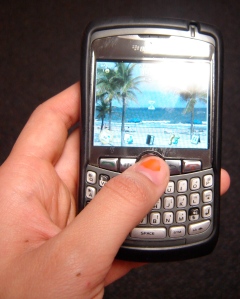 The PDA Craze
The PDA Craze
More and more college students are feeling the need have instant contact with the world around them
By Geena Wardaki, Contributor
You scroll through Facebook as your philosophy teacher lectures on and on. Walking through the quad you have two different conversations at the same time, with friends in different states. At a party you remember you forgot to respond to your professor’s e-mail so you shoot them a quick answer.
Many college students today can say that they have done one of these things all thanks to whatever sort of personal digital assistant (PDA) they use. Apple Computers was the first to use the term PDA in 1992. Meant for business people, a PDA usually came with an address book application, calendar and to-do lists.
Today, the PDA is more like a computer, camera and cell phone all wrapped into one because it is able to do things such as e-mail, surf the web, and instant message. The higher demand for these devices has created new brands: Blackberry, Iphone, Palm and new models.
The group of people using these devices has become younger and younger. According to berryreview.com, companies like Blackberry are now even creating applications geared towards students like Studentberry a Blackberry task management application.
American University Catches the PDA Craze
“In today’s fast paced world neuroses have increased such that I feel the need to be in constant communication with my job and club activities,” said Julia Imbriacio, a student in both the School of Communications and the College of Arts and Sciences.
Many students at American University feel this way, but agree always being able to surf the web or talk to people can be distracting.
“I keep my blackberry out in every class,” said Alexandra Dobin, a student in the College of Arts and Sciences. “I check Facebook every 45 minutes, so you could definitely say I know what everyone is up to.”
Nevertheless, it does not seem the administration is trying to stop students from using their Blackberrys in class. This year the university joined with Sprint and Rave Wireless to create AU Campus Connect.
According the IT Help Desk at American, the program was created to let students be more connected to the campus through PDA devices. Campus Connect has applications like RaveAlert, which sends out messages about emergencies on campus and also lets Students access school e-mail.
“I haven’t looked into AU Campus Connect because it costs more in addition to your monthly plan and doesn’t really add much that my phone can’t already do,” said Daisy Landers, a student in the School of Communications and Sprint subscriber. “It’s a good idea, but I don’t think it is really catching on here on campus.”
Why Would Any College Student Need a Blackberry?
Many students at American University have different opinions on the craze to have everything right at your fingertips.
“I think they are good for professional world but not for kids our age,” said Kelsey Taylor a student in the School of International Service. “There is no reason for us to be e-mailing constantly.”
Other students were dying to get one of these devices because they feel they are often just as busy has people in the professional world.
“ I really always want to have access to my e-mail because the professor that I work for can send me up to ten e-mails a day and I need to respond fast to them,” Imbriacio said. “I am also stage-managing a show right now and people often e-mail me with quick questions that without a blackberry I can’t really get to quickly.”
A New Identity for the Wallflower
Students at American definitely see change from the use of these devices both during and outside of classes. Many saw a huge difference in how people interact at parties, especially for those who had not been so outgoing before.
“The blackberry has given the wallflower a new identity,” Landers said. “It has allowed them to retreat out in the open at parties. It is like they are still being anti-social but they are interacting with people at the same time, just not face-to-face.”
Other students also said that socializing with other people is very different when there is something like a blackberry in your hand.
“I am definitely less aware of my surroundings,” Dobin said. “I always go on my e-mail and the Internet while people are talking to me, I probably miss a lot of what they say.”
Pedals Under Your Feet, Money in Your Pocket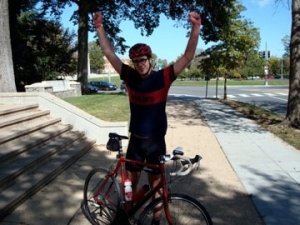
Cyclists looking to save some money and the environment
By Kevin Eng, Contributor
Your bank account balance is down. Your carbon footprint is up. Need a solution? It may be as easy as riding a bike.
Rising gas prices and environmental concerns have boosted interest in bicycles as clean and cheap transportation. As a result, what once was an exclusive club is now becoming more and more accessible. The culture of cyclists has a diverse membership, from racers to commuters and recreational riders.
Getting Racy
Some cyclists argue that the competitive sector of bicycle culture is still an expensive and exclusive club. Racing-style bikes can cost anywhere from one thousand to ten thousand dollars, and that does not include necessary and equally expensive accessories. Greg Abbot, a 13 year racer, said the high cost and need for spandex is unattractive to many people. “Cycling has an aesthetic that does not have mass appeal,” said Abbot.
Jonathan Keephart of the American University cycling team would like to keep it that way. “I think cycling will always be a fringe sport,” said Keephart, “and that’s why it keeps so much of its charm.” Abbot said “Only a handful of people truly understand what it means to be a racer.”
The Hybrid Trend
Bicycle manufacturers, in turn, are fighting the exclusivity of competition by making more recreational models, such as hybrid bikes. Hybrids have elements of both on-road and off-road bicycles and are designed to be comfortable, fun and much less expensive with prices ranging from three hundred to five hundred dollars. This sector of the market has seen the most growth, according to bicycle retailers. Jeff O’hara, manager of Cycle Craft in Long Valley, NJ said hybrids are the most popular type of bicycle sold at his store. O’hara said manufacturers like Trek have found niches in the hybrid market and created specialized products to fill them. For example, Trek makes a line of hybrids for fitness riding, and another designed for comfortable cruising.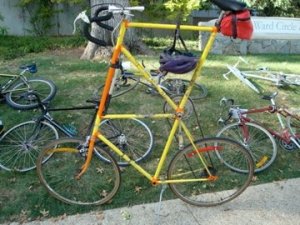
1 World, 2 Wheels
Trek, former bike supplier for Lance Armstrong, has taken their commitment one step further with their “1 World, 2 Wheels” campaign. Over the next two years, Trek plans to give $1.6 million to bicycle advocacy organizations in order to promote bicycling as a “simple solution to the world’s most complicated problems.”
Trek claims the U.S. would save 462 million gallons of gasoline per year by increasing bicycle trips by a half of a percent. The campaign’s goal is to increase the number of bicycle trips in the U.S. from one percent to five percent by 2017. The campaign’s central element is the “Go by Bike Challenge”. Customers pledge to replace a certain number of car-driven miles with bike-ridden miles. Their website claims over 12 million miles have been pledged since July. “Trek has a vested interest in this, but more than that, they know it’s good for the planet,” said O’hara.
The College Scene
Students and faculty at American University are already doing their part. Ryan Bodge, president of the AU cycling team and bicycle advocate for student government, has started a bike share program on campus. Students can register online for free and rent brand new, easy-to-ride bikes with automatic transmissions “There has been a lot of interest in the program and we hope to see more users when the weather warms up,” said Bodge.
Other students with their own bikes are also doing their part. Rachel Johnson, a senior at AU and a bike commuter, said her bike gives her a guilt-free conscience. “My use of a bike is not fueling wars around the world,” she said. Ilana Kalmbach, a sophomore at AU, likes the economy of her bike. “Riding my bike is a lot cheaper than taking the Metro or bus,” she said. “ and I have more freedom to get where I need to go when I need to get there.” Professor Sterling Scroggins is also doing his part by commuting by bicycle. He said, “In the early 1970s, I became convinced that the automobile polluted our environment, destroyed nature, and wasted resources. Bicycle technology seems so elegant in comparison.”
Vegetarian-friendly meals bring students to AU
AU named the Most Vegetarian-Friendly College in the U.S.
By Nadia Galindo, Contributor
IT’S A WAY OF LIFE
Being a vegetarian is more than just not eating meat, it can be a lifestyle. At American University many student choose this lifestyle but it’s not always easy.
Junior Sarah Bower, a vegan cuts out not only meat but all dairy products, eggs, or processed foods containing these or other animal-derived ingredients such as gelatin.
“I decided to become a vegan because I didn’t think it was right for animals to have to suffer for me to have something to eat, there are obviously other alternatives,” said Sarah Bower, AU student.
Bower has been a vegan for 3 years and was a vegetarian for 2 years. She says it is not hard for her to live as a vegan because she believes in her cause. 
AU ACCOMMODATES VEGETARIAN LIFESTYLES
Yvonne Matterson, resident district manager of AU’s food service, Bon Appetit, said, “Our priority at AU is to make sure we have a balance within the dining room which is one of the reasons we have so many different stations.”
AU dining services is now recognized by the peta2 organization as the number one out of the 10 Most Vegetarian-Friendly Colleges in the U.S. Students can go online to the peta2 Web site to vote for AU to advance to the next round in the competition. AU defeated the University of Richmond in the first round, then Georgetown University followed by University of Florida and then Purchase College. AU pulled through to the final round against Wesleyan University. AU was voted to the number one spot Nov. 17 as the Most Vegetarian Friendly Colleges in the U.S.
TOP 10 MOST-VEGETARIAN-FRIENDLY COLLEGES
1. American University
2. Wesleyan University
3. University of Oregon
4. Purchase College
5. University of California, Santa Cruz
6. Ohio University
7. University of Florida
8. University of Delaware
9. University of Texas
10. Georgetown University
DINING HALL BRINGS DELICIOUS DISHES
At each of the AU dining halls, vegetarians have lots of choices. Students can eat vegan Korean barbecue, spicy seitan in miso or vegetarian corn cakes at Cucina Verde, in the Terrace Dining Room. Cucina Verde is a special station in the dining hall with vegan and vegetarian meals. In addition to this station there is a Farm to Fork station that has locally grown vegetables cooked and spiced for AU students.
Chris Moody, executive director of housing and dining, said peta2 contacted AU housing and dining after hearing compliments from a number of students about the vegetarian options in the dining halls. After the dining services team reviewed the peta2 competition online, they decided to submit photos of vegetarian meals prepared in the dining halls for consideration.
“Recognition as one of the Most Vegetarian-Friendly Universities in the U.S. would do a great deal for recruiting and retaining a high caliber student population,” Moody said. “If prospective vegetarian students had confidence that they would not have to worry about vegetarian options on campus, this would help keep AU at the top of students’ lists for possible admission.”
AU CONSIDERED THE BEST
Bower, a transfer student to AU, said she attended Catholic University prior to coming to AU which had little to no options for meals for vegetarian and vegan students. She said AU offers significantly more options to their students who choose to not include meat, eggs and dairy products in their meals.
Moody says there are several ways that students engage in deciding what is provided in the dining halls including comment cards, personal meetings with the chefs and an annual campus-wide survey.
“Students are well represented on the university’s Dining Services Project Team where membership on the committee is over 50% students,” Moody said. “The Project Team is the group ultimately responsible for making recommendations to the university and Bon Appetit for improvement.”
“HOYA Battalion…ATTENTION!”
By Rachael Monnin, Contributor
Andrew Kim, a sophomore in the School of Public Service, didn’t mean to go army in college. He entered American University like any other freshman intending to complete his degree and walk with his diploma into whatever civilian job came his way. “I didn’t have a lot of direction in high school and kind of messed around,” said Kim.
An invitation to participate in a physical training session from a friend already enrolled in AU’s Reserve Officer Training Corps (ROTC) program changed Kim’s college experience completely. “I got hooked” on the discipline and lifestyle of ROTC , “ said Kim.
The life of the military and the opportunity to serve his country, in addition to developing a strong mentor-mentee relationship with Major Dave Hutchinson- a HOYA Battalion staff member- helped convince Kim that ROTC Army would give him the HOYA’s History
HOYA Battalion is not an exclusive program at AU but actually a mixture of schools within the Washington Consortium. This means that American University students in ROTC don’t in fact do much of their training at AU’s campus. They are a part of Georgetown University’s Army ROTC program and the Washington Consortium (George Washington University, American University, Catholic University of America, and Marymount University). It is on Georgetown’s campus that ROTC cadets complete their physical training and a military science class requirement.
Freshman and sophomores have the option of attending a one hour military science (MS) class on Wednesday or Thursdays while juniors and seniors must attend a three hour class on either Thursday or Friday. The MS classes introduce students to the customs and traditions of the U.S. Army and work on building the civilian-soldier relationship that embodies the goal of ROTC.
The MS classes are worth only have a credit on the students’ transcripts and Kim says he wishes they were more. “These (MS) classes are really tough. The officers (in HOYA) emphasize the academics and want (graduating officers) to know how to write and analyze” so they have high expectations for cadets says Kim.
Keeping it together
The MS classes, along with the intense daily physical training, are tough for Kim because he is a full-time student at American.. Jessica Rogers, a senior in SPA and a senior cadet in ROTC for four years, says time management skills are essential to being successful in the ROTC program and as a student. Rogers, who is the AU ROTC public relations representative, has spent hours balancing homework and military training. How do cadets manage it all? “Lots of naps!” say Kim and Rogers.
Both cadets say they don’t ask professors for extensions or special treatment in class because ROTC is a volunteer activity. Kim says, it’s that sense of responsibility that keeps him motivated to get up for physical training at 5:30 a.m. and then complete an eight page paper for class later that day.
The Future
For most seniors who graduate from AU in the ROTC program, they can expect to serve either in the Reserves or as Active members of the military typically for four years. All graduate with the rank of Second Lieutenant.
Kim officially enlisted in the army this past September and hopes to train as a helicopter pilot. “It may turn into a career eventually, but right now I’m still looking at my options,” says Kim. Rogers will be placed in the National Guard in Medical Services but will focus on a civilian position with weekend trainings for the Guard.
Although the cadet experience has not been easy-mentally, physically, or emotionally-both Rogers and Kim said they were pleased with their decision to participate in HOYA and experience a lifestyle unique from any other.
Kim still has two and a half years before his training is completed, but Rogers will graduate in May.
“It’s something different sure, but not something I regret,” says Rogers as she waves to a fellow cadet passing by while dressed in army fatigues. “The camaraderie can’t be found anywhere else,” she added. That camaraderie has helped both students balance the difficulties and triumphs of working towards a degree and training to serve their country.
I love it when folks come together and share opinions. Great website, keep it
up!
The victory affirmed the clay courts were his home. Her standout
scenes including a tender moment as she jams a hypodermic needle into a nosy
patient’s eyeball and a moment where she kills a male prostitute with a pair of
scissors. The trompe l’Oeil in this piece was both intentional and carefully planned from the beginning of the painting
process.